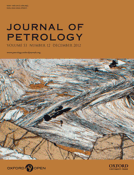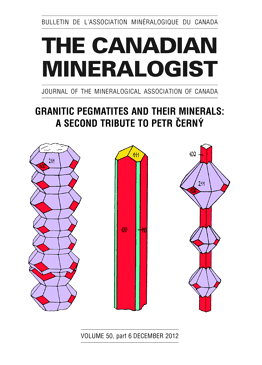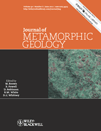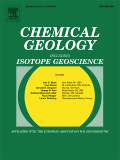
JOURNAL OF PETROLOGY
Scope & Guideline
Pioneering Insights into Igneous and Metamorphic Processes
Introduction
Aims and Scopes
- Igneous Petrology:
Research on the formation, evolution, and characteristics of igneous rocks, including studies of volcanic and plutonic processes, magma generation, and the influence of tectonic settings. - Metamorphic Petrology:
Exploration of metamorphic processes and conditions, including the study of mineral assemblages, metamorphic reactions, and the role of fluids in metamorphism. - Geochemical Analysis:
Application of geochemical methods to understand the composition and evolution of rocks, including the use of isotopic systems to trace sources and processes. - Experimental Petrology:
Laboratory-based investigations that simulate geological processes to understand crystallization, melting, and magma dynamics under varying conditions. - Field Studies and Case Histories:
Detailed fieldwork aimed at understanding specific geological features, rock formations, and their histories, often complemented by petrological and geochemical analyses.
Trending and Emerging
- Machine Learning in Petrology:
An increasing number of studies are utilizing machine learning techniques for data analysis in petrology, indicating a trend towards computational approaches to solve complex geological problems. - In Situ Analytical Techniques:
There is a growing emphasis on in situ methods, such as laser ablation and microanalysis, to obtain high-resolution data on mineral compositions and melt inclusions, enhancing the understanding of petrogenetic processes. - Hydrothermal and Metasomatic Processes:
Research focusing on fluid-rock interactions, including hydrothermal alteration and metasomatism, is gaining prominence as these processes are recognized for their significant roles in magmatic evolution. - Environmental Geochemistry:
Increasing attention is being paid to the environmental implications of petrological studies, particularly related to volcanic emissions, mineral resources, and their impacts on ecosystems. - Geophysical Integration:
The integration of geophysical data with petrological studies is emerging as a significant trend, allowing for a more comprehensive understanding of subsurface processes and structures.
Declining or Waning
- Traditional Geochemistry:
There has been a noticeable decrease in papers focusing solely on traditional geochemical analyses without integration of advanced methodologies such as machine learning or isotopic studies. - Generalized Magma Evolution Models:
Papers presenting broad, non-specific models of magma evolution are becoming less common as the field shifts toward more detailed and localized studies. - Non-Experimental Studies:
Research that does not incorporate experimental methods or modern analytical techniques is less frequently published, indicating a trend toward more rigorous, data-driven approaches.
Similar Journals

CANADIAN MINERALOGIST
Championing Innovative Research in MineralogyCANADIAN MINERALOGIST is a prestigious academic journal published by the Mineralogical Association of Canada, primarily focusing on the fields of Geochemistry and Petrology. Established in 1980, this journal has fostered a rich tradition of scholarly communication, offering a platform for researchers from around the world to share significant advancements and findings related to mineral science. With an impact factor that reflects its relevance within the scientific community, the journal occupies a notable position, ranked in the Q3 quartile within its category according to the 2023 assessments. The E-ISSN 1499-1276 ensures that online access is readily available, making it easier for readers to engage with cutting-edge research. With its headquarters in Quebec, Canada, CANADIAN MINERALOGIST not only contributes to the academic landscape in North America but also plays a vital role globally in advancing the understanding of mineralogy. Its commitment to high-quality publishing supports both the dissemination of knowledge and the nurturing of a vibrant scientific community.

Solid Earth Sciences
Advancing our understanding of Earth's hidden depths.Solid Earth Sciences is a dynamic open-access journal published by Elsevier, dedicated to advancing our understanding of the Earth's subsurface processes and materials. Since its inception in 2016, the journal has established itself as a vital resource for researchers and professionals in the fields of geochemistry, petrology, geology, geophysics, and geotechnical engineering, achieving a notable Q2 ranking in multiple categories as of 2023. With an ISSN of 2451-912X, the journal aims to disseminate high-quality research that enhances knowledge of earth surface processes and the intricate interactions within our planet's systems. The journal is indexed in Scopus, showcasing an impressive rank in various sub-disciplines, with a rank of #96 in Geology and a noteworthy percentile in Earth and Planetary Sciences. Solid Earth Sciences offers a platform for innovative studies, comprehensive methodologies, and cutting-edge technological advancements that cater to a global audience of scientists, academics, and students. With its commitment to open access, it fosters wider dissemination and impact of research outcomes, ensuring that pivotal discoveries reach stakeholders and contribute to real-world applications.

JOURNAL OF METAMORPHIC GEOLOGY
Connecting scholars to the evolving landscape of metamorphic geology.JOURNAL OF METAMORPHIC GEOLOGY, published by WILEY, is a premier academic journal dedicated to advancing the field of metamorphic geology. With an ISSN of 0263-4929 and E-ISSN 1525-1314, this journal covers seminal research that evolves our understanding of metamorphic processes, rock formation, and their implications for the Earth's history. Celebrated for its robust impact, the journal holds a prestigious Q1 category ranking in both Geochemistry and Petrology and Geology, reflecting its critical role in these interconnected fields. The 2023 Scopus rankings further endorse its reputation, placing it in the 85th percentile among Earth and Planetary Sciences in Geology and 76th percentile in Geochemistry and Petrology. Spanning from 1983 to 2024, the journal invites contributions that align with its commitment to rigorously peer-reviewed research, providing an essential platform for scholars and practitioners to disseminate and discuss innovative findings. Engaging with the JOURNAL OF METAMORPHIC GEOLOGY offers an opportunity to explore pioneering studies that shape our understanding of metamorphic geology, making it an invaluable resource for researchers, professionals, and students alike.

Periodico di Mineralogia
Bridging Research and Application in GeologyPeriodico di Mineralogia, published by SAPIENZA UNIV EDITRICE, is a distinguished academic journal based in Italy that has been pivotal in advancing the fields of Geochemistry, Geology, and Geophysics since its inception in 1979. With an ISSN of 0369-8963 and an E-ISSN of 2239-1002, the journal boasts a solid reputation reflected in its Q3 category rankings across these disciplines as per 2023 metrics. The journal’s scope encompasses a broad range of topics related to mineralogy and earth sciences, providing a vital platform for researchers, professionals, and students to disseminate their findings. Despite the absence of an Open Access option, Periodico di Mineralogia remains an essential resource for the dissemination of high-quality research that contributes to our understanding of earth processes and materials. Situated in the heart of Rome at PIAZZALE ALDO MORO 5, it serves as a crucial bridge between academic research and practical applications in geology and planetary sciences.

NORWEGIAN JOURNAL OF GEOLOGY
Connecting Researchers to the Heart of Earth Sciences.NORWEGIAN JOURNAL OF GEOLOGY, published by the Geological Society of Norway, stands as a vital resource in the fields of geology, geochemistry, petrology, geophysics, oceanography, and paleontology. Since its transition to an Open Access model in 2015, this journal has significantly expanded its reach, allowing for greater dissemination of cutting-edge research and insights. With an ISSN of 2387-5844 and E-ISSN of 2387-5852, the journal is committed to fostering collaboration and knowledge exchange among the scientific community. The journal's categorization in the Q3 quartile across various Earth and Planetary Sciences fields underscores its status as a reputable publication, offering researchers, professionals, and students alike a platform to share their findings and advancements in geology. Continuing through its converged years from 2015 to 2024, the NORWEGIAN JOURNAL OF GEOLOGY plays a crucial role in enhancing our understanding of Earth's processes and materials, making it an important reference for anyone engaged in geoscientific research.

GEOCHEMICAL JOURNAL
Illuminating the Path of Geochemical Research Since 1966GEOCHEMICAL JOURNAL, published by the Geochemical Society of Japan, stands as a pivotal platform for researchers and professionals dedicated to the fields of geochemistry and petrology, as well as geophysics. With the ISSN 0016-7002 and E-ISSN 1880-5973, this journal has been disseminating cutting-edge research since its inception in 1966 and continues to provide invaluable insights into the complexities of Earth's processes. Currently categorized in the Q3 quartile for both Geochemistry and Petrology and Geophysics, the journal ranks in the 40th and 36th percentiles, respectively, as per Scopus metrics, reflecting its growing influence and relevance in the scientific community. The journal accepts a range of scholarly articles, aiming to foster a deeper understanding of geochemical phenomena while promoting interdisciplinary collaboration among academicians and practitioners. Although not open access, the GEOCHEMICAL JOURNAL's commitment to quality research and education underscores its vital role in advancing the discourse within geoscience.

CHEMICAL GEOLOGY
Bridging Geochemical Research with Real-World ApplicationsChemical Geology is an esteemed international journal published by Elsevier, dedicated to the rigorous exploration of geochemistry and petrology, with its foundational roots tracing back to 1966. As evidenced by its impressive Q1 ranking in both Geochemistry and Petrology as well as Geology in the 2023 category quartiles, this journal stands as a premier outlet for cutting-edge research and innovative methodologies within these vital fields. With a Scopus rank placing it in the top 10% of Earth and Planetary Sciences, Chemical Geology offers a platform for researchers, professionals, and students alike to disseminate findings that advance our understanding of geological processes and materials. Although it does not currently offer open-access options, the journal remains committed to high-quality publications that contribute significantly to the scholarly community. Located in the vibrant academic milieu of Amsterdam, Netherlands, Chemical Geology is an essential resource for those engaged in the earth sciences, aiming to bridge theoretical insights with practical applications.

Swiss Journal of Geosciences
Your Gateway to Cutting-Edge Geological ResearchSwiss Journal of Geosciences is a prestigious academic journal dedicated to advancing the field of geosciences, published by SPRINGER INTERNATIONAL PUBLISHING AG. Since its inception in 2007, the journal has established itself as a leading platform for disseminating high-quality research findings in various domains related to Earth and planetary sciences, achieving a notable Q1 ranking in Geology as of 2023. With a solid reputation reflected in its Scopus ranking of Rank #72/321, the journal stands in the 77th percentile within its category. Based in Switzerland, the Swiss Journal of Geosciences embraces an open access model, making it easier for researchers, professionals, and students worldwide to access vital geological research without barriers. The journal’s objectives include promoting interdisciplinary research and fostering insights that address both fundamental and applied geoscientific problems, ensuring it remains a crucial resource for those seeking to understand our planet’s dynamics. Engage with pioneering research and contribute to the vibrant community of geoscientists by exploring the impactful articles published within its pages.

Solid Earth
Leading the Charge in Earth Science ResearchSolid Earth is a prestigious open-access journal published by COPERNICUS GESELLSCHAFT MBH, dedicated to advancing the understanding of geological and environmental sciences. With an ISSN of 1869-9510 and E-ISSN 1869-9529, this journal has been at the forefront of the Earth sciences since it became fully open access in 2010. Based in Göttingen, Germany, it features a rich array of interdisciplinary research relevant to earth-surface processes, geochemistry, paleontology, and geophysics, among other fields. The significance of Solid Earth is underscored by its rankings in the Q1 category across multiple related disciplines, demonstrating a strong impact factor within the community. As of 2023, it stands out with an impressive Scopus ranking, pushing the boundaries of knowledge and research excellence. By providing a platform for high-quality scientific contributions, Solid Earth is essential for researchers, professionals, and students looking to explore and disseminate impactful findings in the pursuit of sustainable earth science advancements.

PETROLOGY
Connecting Geochemical Processes with Geological PhenomenaPETROLOGY is a significant journal in the field of Geochemistry and Petrology, published by PLEIADES PUBLISHING INC in the United States. With an ISSN of 0869-5911 and an E-ISSN of 1556-2085, this journal has established itself as a valuable resource since its inception in 1996, continuing to provide insights into various aspects of petrology and geochemical processes through to 2024. It holds a Q3 ranking in the 2023 category quartiles for Geochemistry and Petrology, placing it within the academically relevant tier of journals as recognized by Scopus. Although it does not currently offer open access, the journal remains accessible to researchers, professionals, and students eager to explore the intricate relationships between mineral compositions and geological phenomena. By publishing high-quality research and reviews, PETROLOGY plays a crucial role in advancing knowledge, contesting existing paradigms, and fostering discussions on both fundamental and applied topics within the petrology domain.